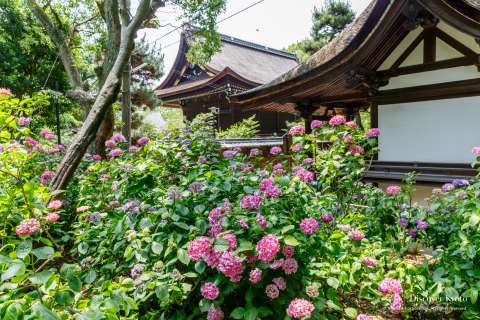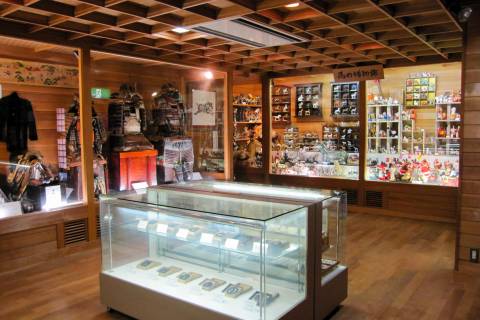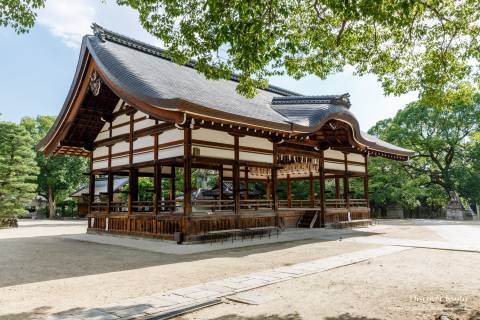Fujinomori Shrine|藤森神社
Overview

A shrine located in southern Kyoto, Fujinomori Shrine is said to have been founded by Empress Jingu even before Kyoto became the capital in the 700s. The origin of Children’s Day was born at Fujinomori Shrine, and today it is known for answering prayers in relation to victory, studies, and horse racing. This shrine has a history of connections to the imperial family, and on the grounds there is a sprawling hydrangea garden lovely in June.
The origin of Children’s Day was born at Fujinomori Shrine, and today the shrine is known for answering prayers in relation to victory, studies, and horse racing.
Features
Honden

Because of its long connection to the imperial family, Fujinomori Shrine’s main sanctuary enshrines many kami who were members of the imperial lineage in life. In the “center seat” of the sanctuary Susano’o no Mikoto, Wakeikazuchi no Mikoto, Yamato Takeru no Mikoto, Empress Jingu, Emperor Ōjin, Emperor Nintoku, and Takenouchi no Sukune are enshrined, with Prince Toneri and Emperor Tenmu in the “east seat” and Prince Sawara, Prince Iyo, and Princess Igami in the “west seat”.
Hydrangea Garden

Fujinomori Shrine’s grounds are made lovely with a hydrangea garden, split into two parts in the north and southwest parts of the shrine. At 5000 m² and containing 3,500 plants, this garden blooms in June during Japan’s rainy season, and the shrine also holds a Hydrangea Festival that month that features various offerings of performances and shrine rituals on certain days. With flowers in a variety of colors from pink and white to blue and purple, you can take a seat in the garden gazebo or enjoy the sight strolling through.
Horseracing Luck

Fujinomori Shrine has a reputation for prayers related to horses and victory, which makes it a particularly popular place for people in the horseracing industry. Fans and bettors may be pleased to find charms for good luck at the track available at the shrine office, which will hopefully help you out with your next derby pick!
Treasure Hall

Free to enter and located just next to the shrine’s office and where you can purchase charms is the Fujinomori Shrine Hōmotsuden (Treasure Hall). Though it is made up of only a single room, there are a lot of interesting treasures contained within, with a focus on horses as well as items related to Japan’s military traditions. One wall is covered in horse figurines ranging from tiny to giant, with samples from various other countries as well as different periods in Japanese history. A set of armor said to belong to Prince Sawara is located next to gold and black saddles and ancient bows, spears, and rifles, and there are also collections of various stationary goods and metalworks such as sword hilts and décor. You can also view a katana made by Sanjō Munechika, a Heian period swordsmith who is known as the creator of some of Japan’s oldest and most beautiful swords.
History
It is said that Fujinomori Shrine is an ancient place of worship founded 1,800 years ago by Empress Jingu before the relocation of the Heian capital to Kyoto, the place where Empress Jingu supposedly raised a battle flag and mound and dedicated tools of battle. In 794, Fujinomori Shrine was chosen as the location of a ritual carried out for the relocation of the capital.
The Honden (main sanctuary) was constructed in 1712 and donated by Emperor Nakamikado. Since over the years two other shrines were integrated into Fujinomori Shrine, the enshrined deities are separated into three “seats” in the sanctuary and include Susano’o no Mikoto and many which have ties to the imperial family, such as Prince Yamato Takeru, Emperor Ōjin, Empress Jingu, and Emperor Nintoku.
Fujinomori Shrine is known as the shrine that originated the practice of Shōbu no Sekku, (also called Tango no Sekku), which evolved in to what is now celebrated on May 5th in Japan as the more general Children’s Day. Originally, Shōbu no Sekku was celebrated by warrior households to celebrate the courage of boys and pray for a son’s health and strength. Shōbu is the word for Japanese iris, but is also a homophone for the word “victory”, and in modern days the shrine is known as home to the gods of victory and horses, which makes it very popular with people involved in the horseracing industry, from owners and jockeys to fans and bettors.
On May 5th each year Fujinomori Shrine holds the Kakeuma Shinji, a ritual in which men called noriko riders gallop horses full tilt down the shrine’s entrance path while performing tricks such as hanging off the saddle by a single foot or performing shoulder stands, all of which were said to have been practiced by samurai in the past. Though several shrines once performed this sort of festival, only Fujinomori Shrine continues to do so to this day.
Events
January 1st | Saitan-sai (New Year’s Ritual) |
|---|---|
January 3rd | Genshi-sai (Festival of Origins) |
Coming of Age Day | Seijin-sai (Coming of Age Ritual) |
January 16th | Okihajime, Oyumihajime |
February 3rd | Setsubun, Tsuina-shiki |
First Day of the Horse | Fujinomori Inari Hatsu Uma-sai |
February 11th | Kigen-sai (Foundation Day Festival) |
March 3rd | Hina Matsuri |
Vernal Equinox | Shunbun-sai |
April 29th | Shōwa no Hi-sai (Showa Day Festival) |
May 1st | Oide-sai |
May 3rd | Mikoshi Mitama Utsushi (Transfer of the Deity to the Portable Shrine) |
May 4th | Yoimiya-sai, Sekku-sai, Green Day Festival |
May 5th | Fujinomori-sai (Fujinomori Festival), Kakeuma Shinji (Trick Riding Ritual) |
June | Ajisai Matsuri (Hydrangea Festival) |
June 30th | Nagoshi Ōharae-shiki (Summer Purification Ritual) |
July 16th | Umi no Hi-sai (Ocean Day Festival) |
August 7th | Tanabata |
Respect for the Aged Day | Keirō-sai (Respect for the Aged Day Festival) |
Autumnal Equinox Day | Shūbun-sai, Soreisha-sai |
Sports Day | Taiiku no Hi-sai (Sports Day Festival) |
November 5th | Shūki Taisai, Hitaki-sai (Autumn Festival, Fire Festival) |
November 23rd | Niiname-sai |
December 23rd | Festival for the Emperor’s Birthday |
1st, 5th, 15th of Each Month | Tsukinami-sai (Monthly Rituals) |
5th of Each Month | Gankake-sai (Ritual for Fulfilling Rituals) |
Access
Address
〒612-0863 京都府京都市 伏見区深草鳥居崎町609
| TEL | 075-641-1045 |
| FAX | 075-642-6231 |
| WEB | http://www.fujinomorijinjya.or.jp/ |
Admission
- General Admission: Free
Hours
- General Admission: 09:00 – 17:00
- Closed: No closing days
Transportation
Gallery
-




 +17
+17
